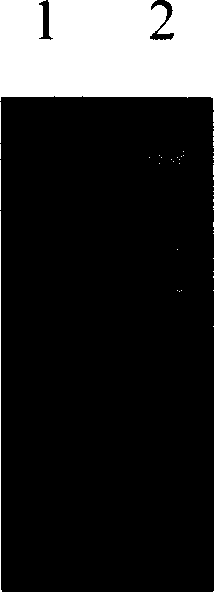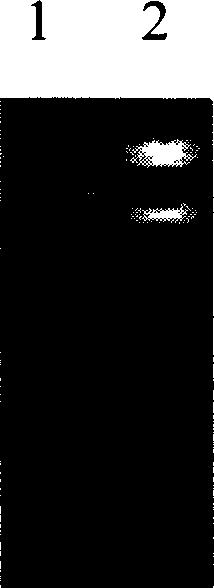Saccharomyce engineering strain for expressing cbh2 gene and its construction method
A technology of genetically engineered strains and yeast, applied in the field of bioengineering, can solve problems such as increased product cost, high product cost, and poor thermal stability
- Summary
- Abstract
- Description
- Claims
- Application Information
AI Technical Summary
Problems solved by technology
Method used
Image
Examples
Embodiment 1
[0029] Example 1. PCR amplification and cloning of the thermophilic Chaetomium cellobiohydrolase II gene
[0030] (1) Synthesis of amplification primers
[0031] The oligonucleotide primers were designed according to the cDNA sequence of Chaetomium thermophila cellobiohydrolase II cloned in the laboratory. The upstream primer is 26 nucleotides long, and the downstream primer is 27 nucleotides long. The primers were synthesized by Shanghai Sangon Biological Co., Ltd. and purified by PAGE. The sequence is as follows (EcoRI and Not I restriction sites were introduced in the upstream and downstream primers respectively, and the underlined part is the restriction site):
[0032] Forward: 5'---CC GAATTC GCCCCCTCTCCTTGAGGAG-----3'
[0033] Reverse: 5'----GG GCGGCCGC TCAGAGCGGAGGGTTGG--3'
[0034] (2) Extraction of total RNA
[0035]A thermophilic fungus Chaetomium thermophilum CT2 was isolated and identified from China, and total RNA was extracted according to the TRIZOL meth...
Embodiment 2
[0099] Example 2. Construction of Pichia pastoris genetic engineering strain expressing cellobiohydrolase II gene
[0100] (1) Construction of the shuttle expression plasmid:
[0101] The recombinant vector was extracted and digested with EcoR I and Not I to obtain the target fragment cbh2; the pPIC9K empty vector was also digested and dephosphorylated under the action of CIAP. The dephosphorylated linearized pPIC9K empty vector and the CBH II obtained after double enzyme digestion were placed under the action of T4 DNA ligase at 4°C overnight to obtain the recombinant expression vector pPIC9K-CBH II, and the recombinant vector was transferred into the large intestine Bacillus JM109 was amplified. Pick the white single colony and quickly extract the plasmid for enzyme digestion identification ( image 3 ).
[0102] (2) Construction of yeast engineering strain expressing cellobiohydrolase II gene:
[0103] a. Linearization of the shuttle expression plasmid:
[0104] The re...
Embodiment 3
[0113] Example 3. Induced expression of genetically engineered bacteria cellobiohydrolase II protein
[0114] (1) Pick a single colony, place it in a 250mL shake flask with 25mL BMGY medium, and culture it at 28-30°C / 250-300rpm until OD600=2-6 (about 16-18h);
[0115] (2) Centrifuge at 1500-3000g for 5 minutes at room temperature, collect the bacteria, and resuspend the bacteria in BMMY to make OD600=1.0 (about 200mL);
[0116] (3) Place the bacterial solution obtained in step 2 into a 1L shaker flask, seal it with double-layer gauze or cheesecloth, and place it on a shaker at 28-30°C / 250-300rpm to continue growing;
[0117] (4) Add 100% methanol to the medium every 24 hours to a final concentration of 0.5% (about 1 mL);
[0118] (5) Samples were taken at 24, 48, 72, 96, 120, 144, and 168 hours to detect the expression of the cbh2 gene in yeast.
PUM
 Login to View More
Login to View More Abstract
Description
Claims
Application Information
 Login to View More
Login to View More - R&D
- Intellectual Property
- Life Sciences
- Materials
- Tech Scout
- Unparalleled Data Quality
- Higher Quality Content
- 60% Fewer Hallucinations
Browse by: Latest US Patents, China's latest patents, Technical Efficacy Thesaurus, Application Domain, Technology Topic, Popular Technical Reports.
© 2025 PatSnap. All rights reserved.Legal|Privacy policy|Modern Slavery Act Transparency Statement|Sitemap|About US| Contact US: help@patsnap.com



